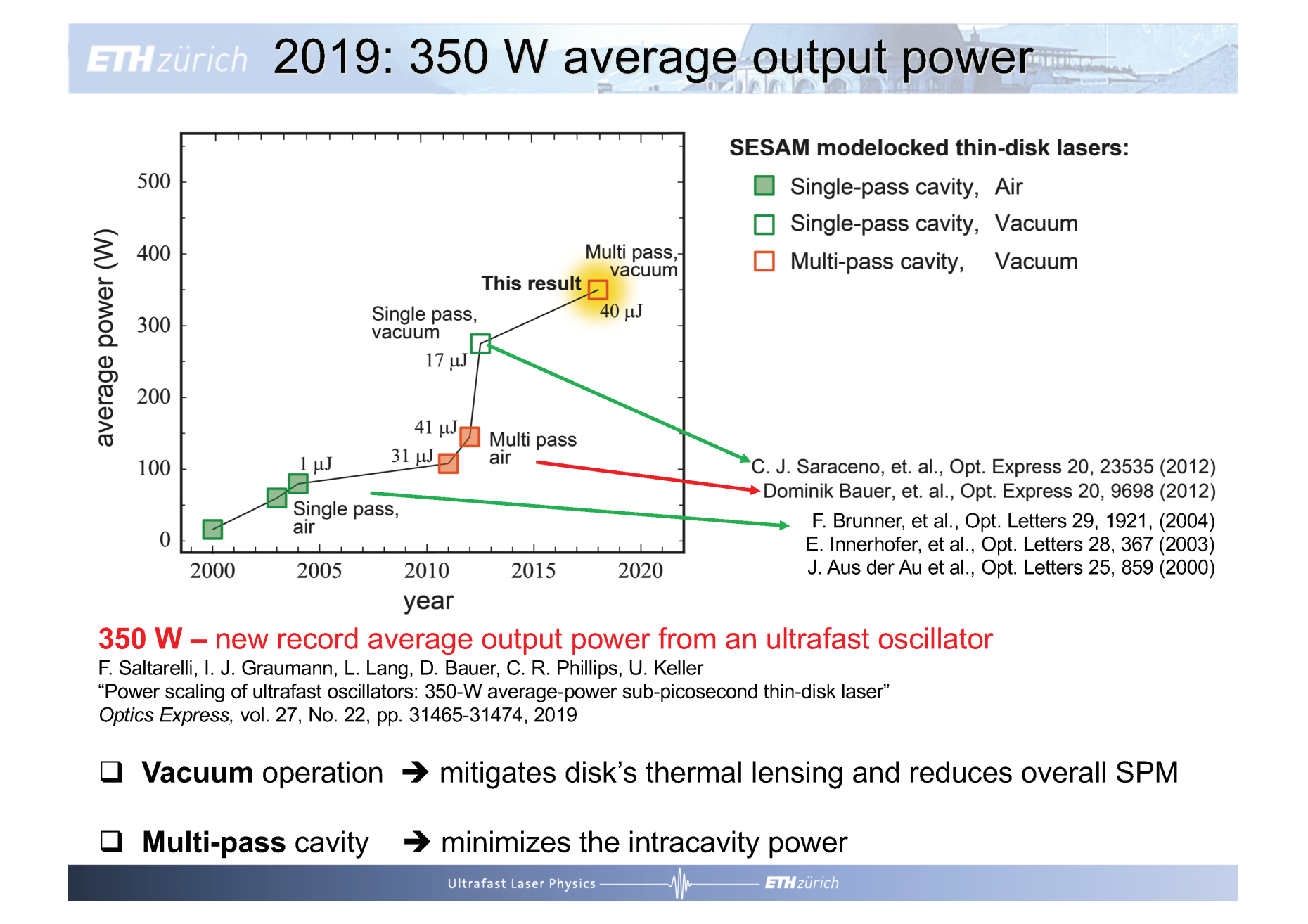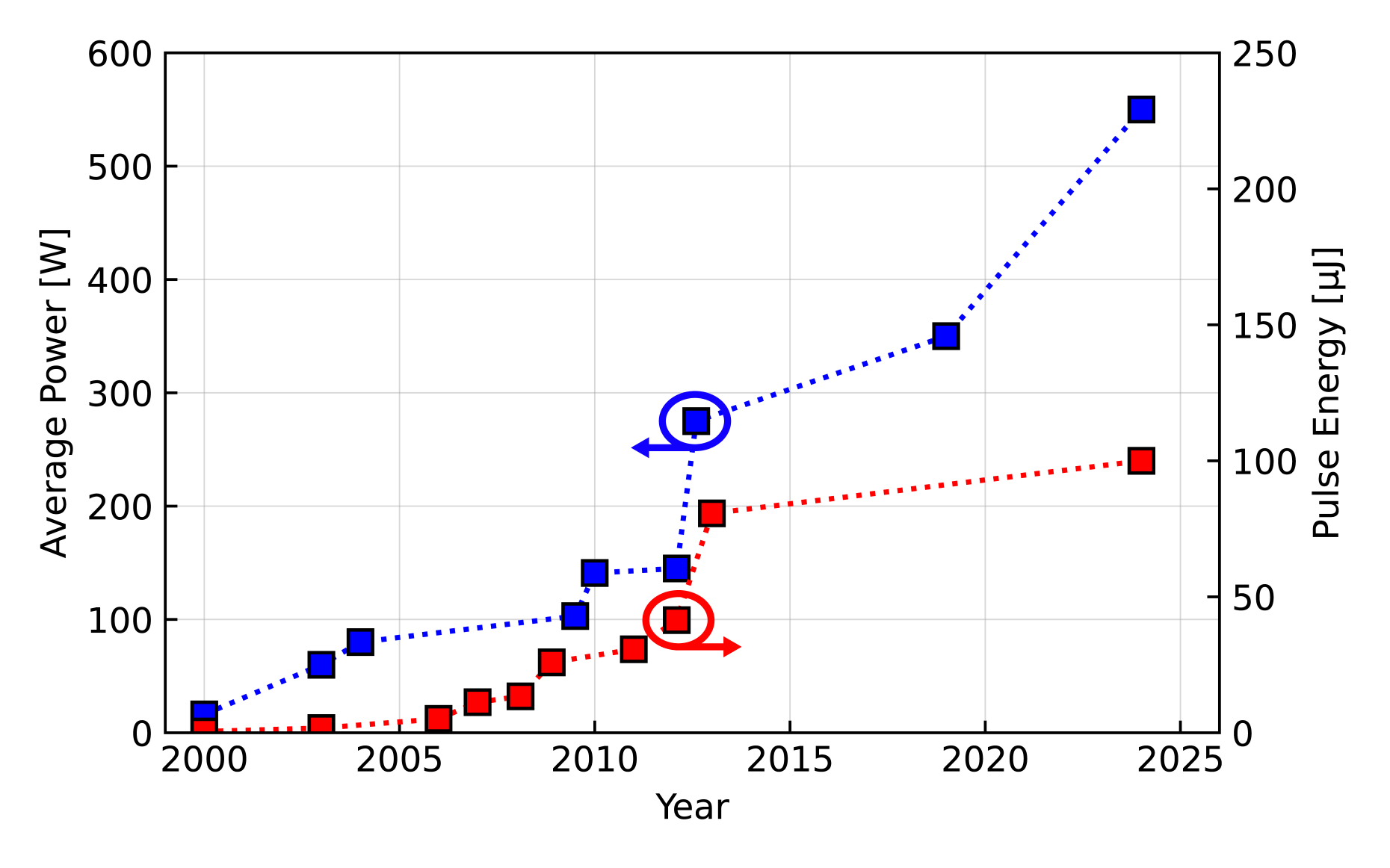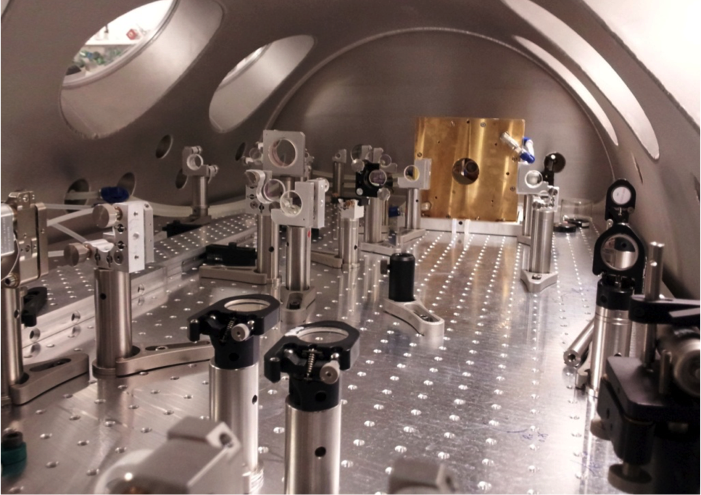Power and energy scaling
Power-scalable ultrafast technology
SESAM modelocked thin-disk lasers provide the highest average power and pulse energies of any ultrafast oscillator technology. Their power scaling capabilities are clearly illustrated in the exponential increase of average power and pulse energy that has been achieved since their first demonstration in the year 2000.

Milestone record results for average power and/or pulse energy
2012
SESAM modelocked Yb:YAG thin disk laser: 275-W average output power, 583-fs pulse duration, 16.3-MHz pulse repetition rate, pulse energy 16.9 µJ, peak power 25.6 MW
external page "275 W average output power from a femtosecond thin disk oscillator operated in a vacuum environment"
Download Download (PDF, 1.3 MB)
2014
SESAM modelocked Yb:YAG thin disk laser: 80-µJ pulse energy, 242-W average output power, 1.07-ps pulse duration, 3.03-MHz pulse repetition rate, peak power 66 MW
external page "Ultrafast thin-disk laser with 80 μJ pulse energy and 242 W of average power"
Download Download (PDF, 508 KB)
2019
SESAM modelocked Yb-doped thin disk laser: 350-W average output power, 940-fs pulse duration, 8.88-MHz pulse repetition rate, pulse energy 39-µJ, peak power 37 MW
Include PDF for download, Ref. 461
News item: record-high 350-W average output power from an ultrafast laser
2019
Photonics Spectra, Oct. 2019, C. R. Phillips, U. Keller,
external page "Advances in Ultrafast Multi-100-W Average-Power Thin-Disk Lasers"
Download Download (PDF, 2.2 MB)
Harnessing nonlinearities
SESAM-modelocked TDLs operate in the soliton modelocking regime. This means a careful balance between nonlinear phase (due to self-phase modulation) and negative group-delay dispersion needs to be achieved within one round-trip of the laser pulses in the laser resonator. For power and energy scaling, careful design guidelines need to be followed to avoid excessive nonlinearities and maintain stable modelocking. In particular, at the very high intracavity peak powers typically present in such oscillators, propagation through the air inside the resonator can become the main contribution to the total nonlinear phase shift of the pulses. In order to overcome this limitation, we have recently demonstrated that operating these oscillators in a medium vacuum environment allows to power and energy scale while keeping simple resonator designs.
SESAMs for high-power oscillators
Modelocked TDLs push all intracavity elements into extreme conditions. In particular, SESAMs must be designed and fabricated accordingly. We provided guidelines for a significant increase of the damage threshold of these non-linear reflectors in a recent study:
"external page SESAMs for high-power oscillators: design guidelines and damage thresholds" - Download Download (PDF, 1.1 MB)
In addition, improvements of thermal properties and surface quality of these SESAMs represent a crucial step for further power scaling. As a part of our ongoing efforts to reach the kilowatt average power milestone from a modelocked oscillator, we have recently demonstrated together with our industrial partner external page CMS, substrate‑removed large-area high‑power SESAMs, processed post‑growth on a heat spreaders with better thermal properties than the standard GaAs substrate (for example silicon carbide):
external page "Optimized SESAMs for kilowatt-level ultrafast lasers" - Download Download (PDF, 5.5 MB)
Previously we have understood and solved the damage problem for SESAMs and improved the flatness and thermal lens of SESAMs with a novel heatsink technology. However there is also the "SESAM rollover" limitation: SESAM parameters can be adjusted for shorter pulse operation with strain-compensated fast SESAMs with a higher damage threshold and a higher rollover.
Download "Improved SESAMs for femtosecond pulse generation approaching the kW average power regime" - Ref. [413] (PDF, 3.6 MB)

